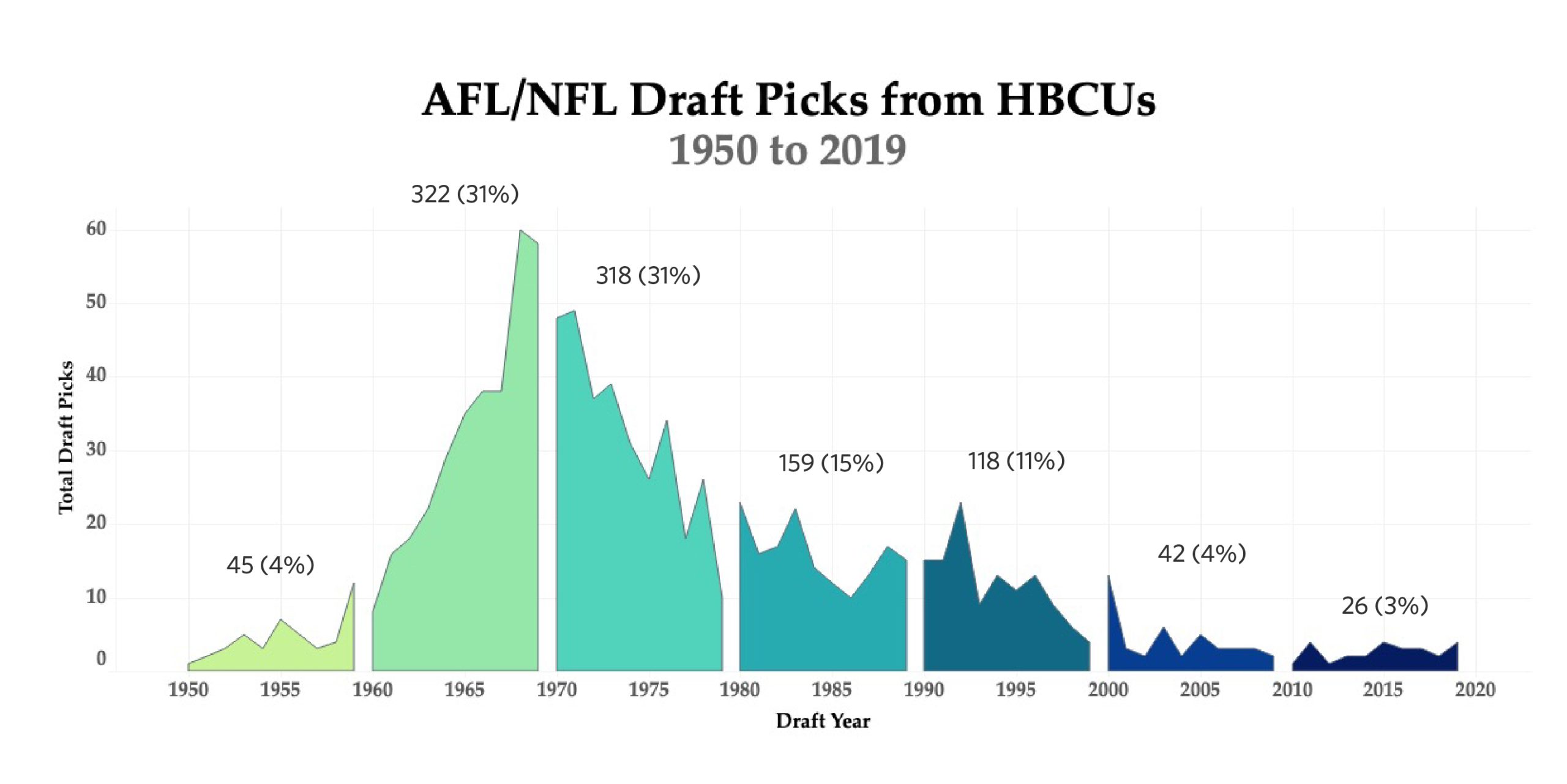The history of football in the United States is as much a story of what’s taken place on the field as it is of American history itself. A historical look at the role of Black athletes and HBCUs in the sport, specifically through the lens of the NFL Draft, provides us with many rich stories about the development of football as we currently know it as well as the larger American society it operates within.
Since the early part of the 19th century, football drafts have been the primary connector between the sport’s amateur, collegiate training ground and the system of professional leagues and franchises. The data analysis and evaluative techniques used to measure Xs, Os and athleticism have become more sophisticated, and they take center stage leading up to the draft. But zooming out and looking at historical draft picks themselves can tell a multitude of nuanced stories that pertain to the gridiron and how it intersects with the larger world.
A History of Football and Black Athletes
American football emerged during the Antebellum, Reconstructionist period of the country’s history. The first recorded game was played between Rutgers and Princeton in 1869. The fledgling game began to grow in popularity in the 1920s, and by the 1940s, the National Football League (NFL) had established itself as the dominant and most lucrative of professional football leagues. But for Black professional football players, those were dark years. In 1920, when the NFL formed, there were several Black players. But in 1932, when the proudly bigoted George Preston Marshall brought his Washington Redskins into the league, there were only two Black players, and by 1934, largely at Marshall’s urging, there were none. The NFL didn’t draft a Black player back into the league until 1949.
In 1950, the NFL absorbed the All-American Football Conference (AAFC). Although only three of the AAFC’s teams were left intact, the league’s remaining players were dispersed among the NFL’s teams in a special draft. That merger process brought a number of Black players into the NFL as all but two of the AAFC’s teams had Black players.
In 1960, the professional football ecosystem and its place in the larger desegregation space would once again be shaken by the arrival of the American Football League (AFL). Because the NFL was so popular and lucrative, many additional wealthy capitalists wanted to establish their own NFL teams in other markets, but the existing owners turned them away. Rather than accepting that rejection, several of them joined forces in 1960 to create the AFL as a rival league in smaller markets that still had a lot of demand for Sunday football. The AFL was considered a funner, more innovative league, promoting downfield passing much more than the run-heavy, defensive battles the NFL seemed to cultivate. And the AFL was also much more willing to draft players from smaller colleges and universities, including the Historically Black Colleges and Universities (HBCUs).
Between 1960 and 1966 the AFL and NFL held separate drafts where they competed for top talent largely from the same talent pool of US collegiate athletes. It was during this period that Black football players at HBCUs saw the gates of opportunity to enter into and play at the professional level open up significantly.
HBCU’s and the Draft
An analysis of 80 years of picks from 21 of the present day’s most successful HBCU football programs provides some insight into what this period meant for football drafting and HBCUs. Between 1950 and 1959, there was a total of 45 NFL Draft picks from the HBCUs. Between 1960 and 1966, there were 166 across the competing AFL and NFL Drafts. In anticipation of 1970 merger between the AFL and NFL, the leagues consolidated their drafting activity into a common NFL Draft. The three common drafts conducted between 1967-1969 resulted in a total of 156 draft picks from the selected HBCUs. In total, the 1960-70 period produced 31 percent of the total draft picks for the 80-year period. In following decades, draft picks from these HBCUs would gradually decrease, with 318 (31 percent) being recorded between 1970-80 and a historical low of 26 picks recorded between 2010 and 2019.
 On theme of the story in the ‘70s is the broader integration of predominantly white colleges and universities that started providing more opportunities for Black athletes to compete in collegiate sports.
On theme of the story in the ‘70s is the broader integration of predominantly white colleges and universities that started providing more opportunities for Black athletes to compete in collegiate sports.
Undoubtedly, there are several more narratives and interpretations that can be solicited from the data and accompanying visualizations. As the systems of collegiate and professional football once again find themselves on the potential cusp of fundamental transformations, I hope historical draft data can be used to power both reflective and forward-looking conversations about society as well.

Leave a Reply
The comments are closed.